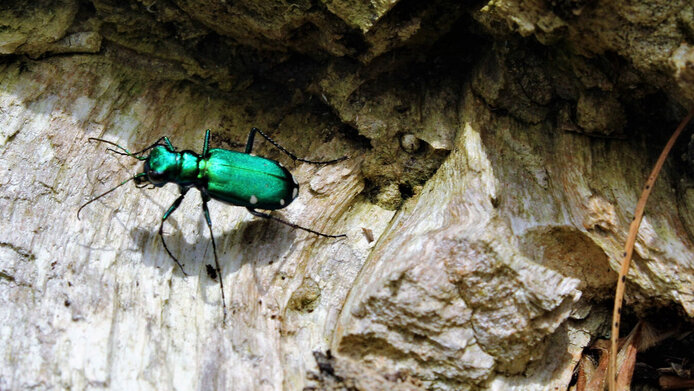Forests and the climate 100 years from now

Climate change makes it imperative for us to phase out fossil fuels as quickly as possible. When it comes to finding alternatives, the forest already has a key role to play. Many houses are being converted from gas-based heating to wood pellet heating, and the ecologist Tord Snäll from the Swedish University of Agricultural Sciences is convinced that forests and their use will become even more important in the future: “If we want to produce the same amounts of energy and discard one source, we will have to replace it with something else.” The effects of increased forest use are difficult to predict. – One thing is certain: an increase in intensive forestry goes hand in hand with a reduction in biodiversity, which has far-reaching effects.
Simulating this complex situation is the goal of joint international research under Tord Snäll's coordination. One of the participants is the International Institute for Systems Analysis IIASA, based in Laxenburg near Vienna. Their contribution is funded by the Austrian Science Fund FWF. The aim is to make forecasts of forest use and its impact on biodiversity and human well-being for the next one hundred years.
The rich diversity of beetles
Making precise forecasts for such long periods of time is a challenge fraught with great uncertainty. One possible approach is to run through different scenarios and make comparisons between them. For this purpose, the project team is investigating how forest use changes when the overall system is optimised from very different angles. “We explore what the world will look like if the focus is on maximum profit, on the greatest possible biodiversity, or on human well-being,” Snäll explains.
The Austrian project partner IIASA, under the leadership of the mathematician and economist Nicklas Forsell he has developed a global land use model called GLOBIOM.
The aspect of biodiversity is particularly important. To this end, Snäll and his team used data from project partners who deal with beetle species native to the forest. “We knew that diversity of species is very high among beetles and that our partners in Germany, but also in Norway and Finland, have very good data on this issue,” reports Snäll. This diversity of beetle species makes these animals a good model for forest biodiversity, and the findings showed that forestry tends to reduce biodiversity. “In many cases, forestry means cutting down forests and then reforesting them,” says Snäll. Some beetle species take many years to establish themselves in the forest. As the typical forest management cycle does not leave enough time for that, forest management causes a loss of biodiversity.
Biodiversity versus CO2 reduction?
But can one justify focusing on factors such as biodiversity in forest use at all, given the pressing issues of the climate crisis? Shouldn't CO2 reduction be the uppermost goal? Snäll turns the table on the question: “You could just as well ask why we should focus only on the CO2 issue and not more on biodiversity.” In his opinion, these two things cannot be separated. He points out that forests richer in species are more robust against pests or wind damage, and he adds: “It is already well known that biodiversity in an ecosystem means higher benefits for people at different levels, including higher productivity.” The biodiversity of beetles increases with higher diversity of tree species.
The forest as a source of recreation
Hence, biodiversity is closely linked to climate change. Snäll and his team were also interested in less obvious connections, however, such as the question of how different types of forest affect people's well-being. The latter research is facilitated by a cooperation with psychologists who study what kind of forest people perceive as particularly conducive to wellbeing. The investigation of this aspect is unusual but fully intentional. “When planning our research we were very interested in expanding it to new disciplines,” Snäll notes. The investigations belong to the field of so-called “ecosystem services”, which include not only the stability of the climate and the supply of goods, but also, for example, cultural values and health effects.
A global model
All these aspects can be simulated at the national level by the partner organisations in Germany, Norway, Sweden and Finland. “At the state level, there are very detailed models that large forestry undertakings use for their practical work,” Snäll explains. The Austrian project partner IIASA, under the leadership of the mathematician and economist Nicklas Forsell, is responsible for scaling it up to the global level. With his team, Forsell has developed a global land use model called GLOBIOM. “To this end, the planet is divided into pixels, and forest dynamics are modelled at this level. In parallel, we simulate the economic changes of society,” says Snäll. The GLOBIOM simulation environment thus brings national forest-use models under one common umbrella. In the case of Snäll's home country Sweden, for example, this means that GLOBIOM calculates a certain amount of wood that Sweden is supposed to supply to meet increasing global demand; the way the country can provide this amount is investigated at the national level. The simulations at the global level are the next step in the project, which will run until the end of the year.
Personal details
Tord Snäll is an ecologist at the University of Agricultural Sciences (SLU) in Uppsala. He is interested in the links between forest use and biodiversity with a view to climate change and “ecosystem services”. The international project BIOESSHEALTH started in 2019 and will run until the end of 2022. The research of IIASA was funded by the Austrian Science Fund FWF with EUR 86,000.
Publications
Functional structure of European forest beetle communities is enhanced by rare species, in: Biological Conservation 2022
Choosy beetles: How host trees and southern boreal forest naturalness may determine dead wood beetle communities, in: Forest Ecology and Management 2021
Traits mediate niches and co-occurrences of forest beetles in ways that differ among bioclimatic regions, in: Journal of Biogeography 2021






